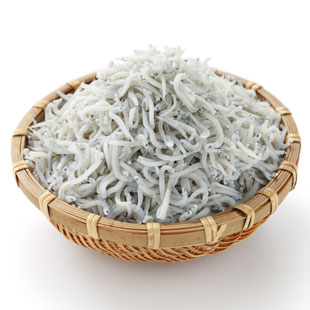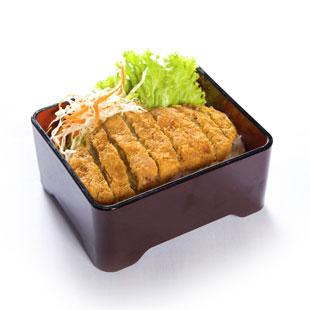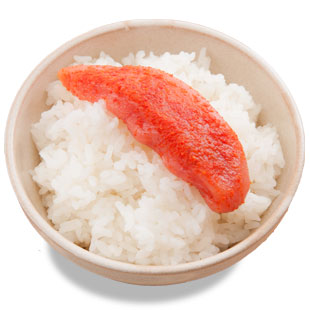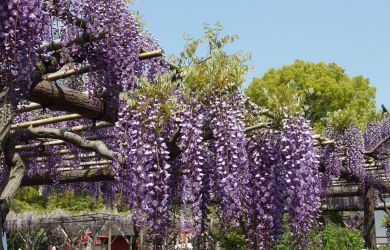

In my last few days in Japan, among the food I’ve eaten were sushi, yakitori, koya dofu (freeze-dried tofu), and summer stir-fried vegetable; spaghetti with Japanese mushrooms, soy sauce, and butter; sake lees gelato, a teishoku (set meal) comprising yakizakana (grilled fish), vinegared spinach, kinpira gobo (sauteed burdock), miso, and rice; mentaiko and cheese burrito (I was hungover); ice cream-filled senbei (rice cracker), ochazuke (green tea over rice), karepan (a Japanese curry-filled donut), Iwagaki oyster risotto, and a “Caprese” salad with tomato, tofu, and shiso. This list, while barely touching on the food available in Japan today, gives a glimpse into the range out there.
Ancient Japan was a paleo banquet of native meats and vegetables: wild deer and boar, mushrooms, sudachi lime, ginger, sansho pepper, myoga, nuts, pears, fish, and shellfish. Washoku (traditional Japanese cuisine) took shape over the Muromachi Period (1392–1573) and consolidated during the Momoyama Period (1573-1615). The influences of the extravagant feasts of the imperial court, daikyo ryori, during the Heian Period (794–1185); Buddhist monks’ vegetarian shojin ryori of the 13th century, and cha-kaiseki (tea cuisine) in the late 16th century, resulted several foundation principles of washoku, such as seasonality, presentation, and a meal comprising ichiju sansai (“one soup, three side dishes”). Sunomono (vinegared food), aeomono (vegetables, fish dressed with vinegar, sesame, or miso), and nimono (food boiled in dashi) are some examples of classic washoku dishes.
Today, you can find washoku cuisine on a menu next to a croquette or Caesar salad. Surveys conducted into eating habits in modern Japanese homes show a diverse array of cuisines: foods like gyoza, miso, curry rice, mabodofu, tonkatsu, and soba. For visitors, Japanese “must-eat” lists include sushi, tempura, kaiseki, yakitori, ramen, and udon. Half of these are actually fairly modern foreign imports, introduced only within the last 100 or so years.
Following hundreds of years of Japan being closed off to the rest of the world, the Meiji Restoration (1868) had an imperative to build a stronger, more modern Japan. This included lifting a centuries-long ban on eating meat, encouraging Western-style eating, and allowing Japanese chefs to travel abroad—particularly to France—to study cooking. New sets of foods and beverages arrived. Postwar government-backed kitchen cars traveled around, spreading Western-style staples such as meat, milk, and eggs, which even impelled housewives to take foreign cooking classes in major cities. Italian former prisoners of war in Japan opened up Italian restaurants. The economic boom of 1960s meant more disposable income for spending on exotic foreign tastes. This trend of adopting foreign ingredients and new cooking techniques continued; the Japanese are said to be good at taking foreign concepts and modifying them for Japanese tastes, and food is no exception.

The resulting modern Japanese cuisine is one where Western dishes are reinvented into Japanese styles, a concept known as yoshoku and wafu, where Japanese ingredients get new foreign treatments and foreign ingredients get Japanese treatments, respectively. These modern manifestations can be found on menus everywhere from high-end restaurants to izakaya, family restaurants, and convenience stores.
Tokyo-based Michelin joints and high-end restaurants serve up dishes like a Monaka (traditional wafer) filled with foie gras, Japanese persimmon, and smoked radish (Den in Jimbocho); Hirame sashimi with a passion fruit and ponzu sauce (Esaki in Aoyama); an Ayu croquette, with the bones and head French-fried, and the flesh mixed with potatoes for the croquette (A nu retrouvez-vous in Shibuya); Kuruma prawn served with Hokkaido uni (sea urchin), soft scrambled egg and cheese, and prawn consomme (Florilege in Minami-Aoyama); Akage beef filet charcoal with sweet sauteed onions and crispy poached egg (Ryugin in Roppongi); and grilled wild ayu served with citrus sudachi mousse (Kifu in Shinjuku).
At izakaya and tachinomi (standing bars), you can find mochi pizza topped with shirasu (whitebait), gruyère, and black pepper; mentaiko (cod roe) and mayonnaise udon “pasta”; squid, daikon, and cheese gratin; a salad of onion, bonito flakes, and olive oil; crunchy smoked pickled daikon topped with a little brie; avocado slices topped with scallop minced with ginger; and a spring roll filled with sweet adzuki bean paste!

Family and specialty restaurants—and even convenience stores—offer an assortment of modern Japanese dishes and flavors, such as omuraisu (omelette rice); tonkatsu sandwich; dried cod and sticks; yukimi daifuku (ice cream wrapped in rice cake); octopus, broccoli, and pesto salad; mentaiko, cheese, and potato penne; hayashi (hashed beef); steamed buns filled with “pizza sauce” and cheese, or black sesame paste and fresh cream.
With everything from curry-filled donuts to grilled ayu with sudachi mousse, there’s been no better time to be hungry in Japan.







